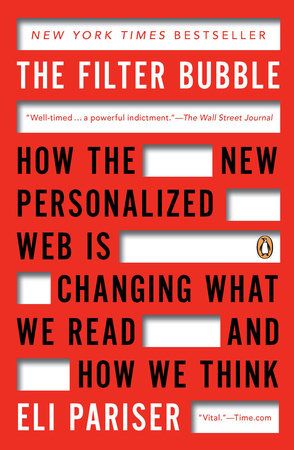The Filter Bubble

The Book in 3 Sentences:
Eli Pariser “The Filter Bubble” gives the reader a clear understanding of what we are often baffled by - how does google or facebook know what we are thinking. “The Filter Bubble” studies the personification of the web, and how instead of making our lives easier, it serves as an “invisible propaganda of our own ideas.” The book describes the many avenues companies like Amazon, Google, and Facebook have to shape who we have become, how we think, and what we want.
My Top 3 Quotes
“...personalization filter serve up a kind of invisible autopropaganda, indoctrinating us with our own ideas, amplifying our desire for things that are familiar and leaving us oblivious to the dangers lurking in the dark territory of the unknown.”
“Curiosity is aroused when we’re presented with an “information gap.”
“But what’s troubling about this shift toward personalization is that it’s largely invisible to users and, as a result, out of our control.”
HOW THE NEW PERSONALIZED WEB IS CHANGING WHAT WE READ AND HOW WE THINK
By Eli Pariser
304 pp. Penguin Books; Reprint edition (April 24, 2012). $19.00
Most of us have been completely baffled as to how companies like Google and Facebook knew what we wanted before we even searched for it. Were they listening to us? How did they know? Those instances are wearisome but Eli Pariser, in The Filter Bubble, describes how the process is achieved. While the actual process is not known, companies rely on complex coding to categorize individuals in order to know every aspect about them. With that personalized information, companies are able to target individuals with news feeds, purchase recommendations, or retargeting.
Pariser thesis in The Filter Bubble is that a personalized web is a constant part of our existence and serves as an “autoprogapanda” that echoes what we believe. To test this idea, Pariser and a friend googled the same thing, but both of them got two different results. For example, if one is a viewer of Fox News, the personalized web will give results of similar ideology. Consequently, a personalized web that amplifies our desires, also limits our understanding of the world.
The first half of the book describes the Filter Bubble, but the book loses its vision when it tries to expand that notion in the second half. For example, the chapter called “The Adderall Society,” Pariser compares personalized web to adderall, where individuals become hyper or narrow focused, instead of creative in search for new discoveries. While that might be true, there is little imperative proof of that thesis. In addition, the book lacks coherent focus in describing how governments can censor the internet and how that is connected to the Filter Bubble.
Pariser concludes with possible solutions for the Filter Bubble. He argues that individuals should have control over their personal information. While Pariser does not expand on how that would look like, at least it leaves the reader pondering those difficult questions. The Filter Bubble gives the reader a good understanding of how companies are using codes to feed us what they would like us to see.
The links to the book are affiliate links. This means that, at zero cost to you, I will earn an affiliate commission if you click through the link and finalize a purchase.
